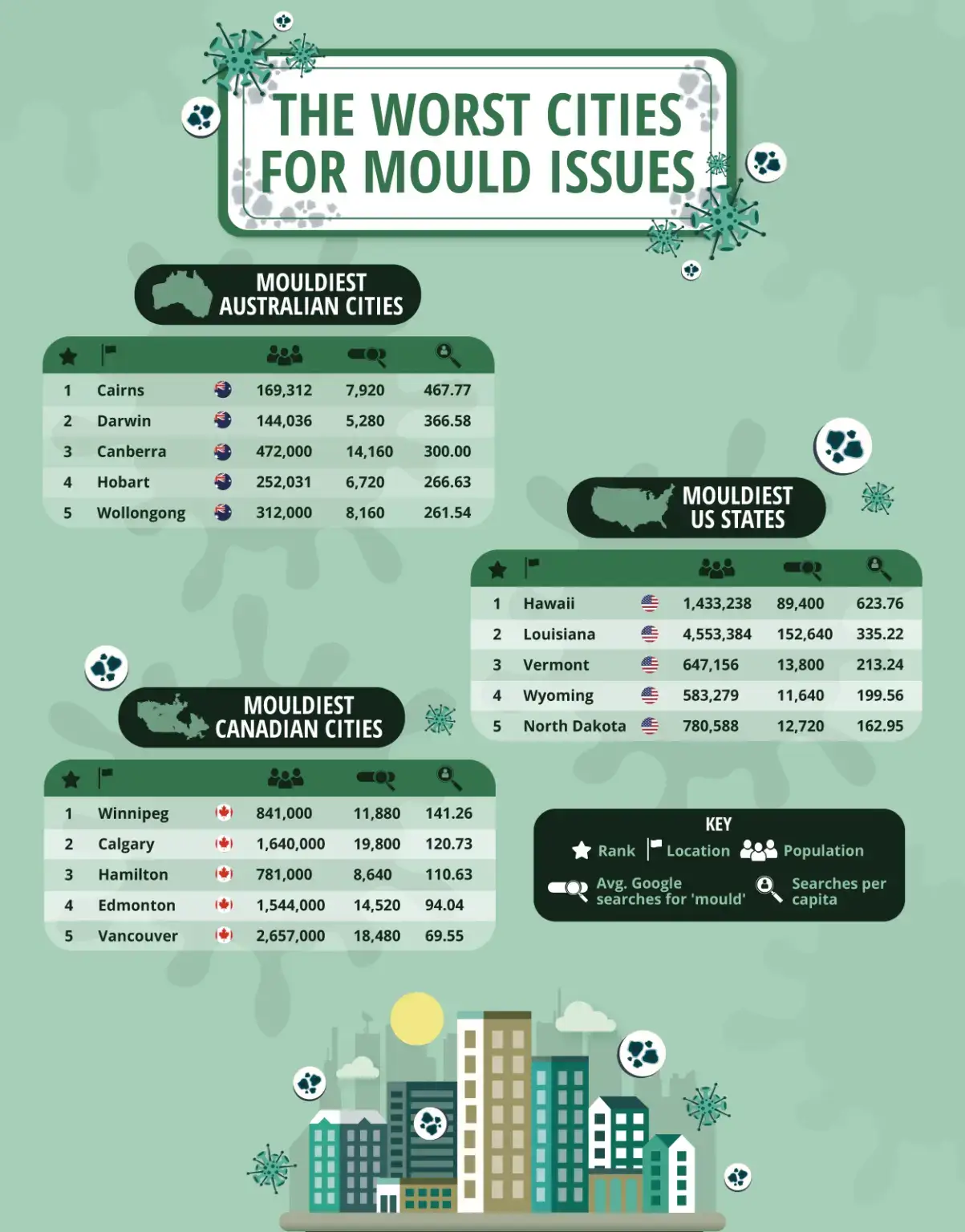The Burrow

Caused by damp and ventilation problems, it’s estimated that 30% of homes worldwide are affected by mould damage.1 Persistent mould can not only lead to damage to your possessions and the structure of your property; but because mould can release something called mycotoxins, which is toxic to humans, it can cause health issues too – most commonly, respiratory problems.
As home and contents insurance experts, we recognise that prominent mould is a regular issue in many cities across the globe, and it has been known to cause damage to the home. With this in mind, we decided to take a look across Australia and the USA to discover the cities and states that are most impacted by mould. To do this, we looked at monthly search volumes for the topic.
So, read on to discover which areas are impacted by mould the most, as well as tips on how you can prevent it from entering your home.

Cairns is officially the mouldiest city in Australia, with its 169,312-strong population searching for ‘damp issues’ 7,920 times every month; or 467.77 searches per capita.
Darwin and Canberra aren’t far behind, with 366.58 and 300.00 searches per capita respectively, with Hobart and Wollongong making up the top five.
With summers hot and humid in Cairns, Darwin, and Wollongong; it makes sense that damp can be an issue, with humidity a prime space for mould to grow and spread. Other cities like Canberra and Hobart experience damp, cold winters, and can also be at risk of mould.
Looking at the US, Hawaii is the mouldiest state, with its population of 1,433,238 making 89,400 monthly searches for ‘damp issues’, totalling 623.76 searches per capita. Again, with the warm temperatures and island location in the Pacific, Hawaii is the ideal place for mould to grow.
Louisiana – a quite humid state in the US – comes in second place, with 335.22 searches per capita, and the most searches for ‘damp issues’ out of our top five, at 152,640 every single month.
The other three mouldiest states can all be found in the north (Vermont, Wyoming, and North Dakota); showing that if you don’t take steps to prevent mould, it can still grow even in cold climates – it’s all about the humidity and dampness in the air.
Caused by poor ventilation and an excess of moisture, mould starts to grow when there’s a build-up of condensation. Here’s how you can stop that from happening:
Mould thrives in humid conditions, which is why it often grows in the bathroom. Realistically, you don’t want humidity in your home to reach any higher than 50%; so turning on your aircon – or investing in a dehumidifier if you don’t have an air conditioning system – can help to prevent mould.
Just make sure you check humidity levels a few times a day, as it can change at different times.
Because mould grows in warm, damp areas, leaks can be a huge contributing factor. Make sure you’re checking your house regularly, paying special attention under your washing machine and dishwasher, and behind your toilets and sinks.
If you spot a leak, then arrange for a plumber to come and fix it for you.
When winter comes around, it can be tempting to hang your laundry on a clothes horse, but without proper ventilation, the moisture from your washing can seep into your walls, which could cause mould.
If you have a garden, hang your washing out to dry, and if you don’t have access, then investing in a tumble dryer should prevent any risk of mould spreading.
If you find that mould has already started growing, then the good news is, there are lots of anti-mould products you can use to target the area; and there are even suggestions that a combination of vinegar and alcohol can help to kill it, too.
If you do discover a severe mould problem in your house, it typically isn’t something you can claim on your home insurance. Adrian Taylor, General Manager of General Insurance at Compare the Market AU, explains:
“Mould can easily grow over time if affected areas aren’t cleaned regularly, which makes it hard to insure against. Home and contents insurance will cover damages and pay for repairs if the mould was the result of another event that is insured, like storm or flood damage to the home.”
Taylor notes that it is important to get on top of mould as it can damage the home, personal belongings and lead to health problems as well.
“If you check your insurance policy and you’ve had an insured event that leads to mould, you could claim the cost of replacement belongings or repairs to affected areas. Check the Product Disclosure Statement (or PDS) for details.
“Make sure you keep the home clean and if you live in a damp area, it may well be worth investing in modern air conditioning or a dehumidifier as well. Otherwise, overtime mould can build up and you likely won’t have any insurance cover for it.”
Sources:
Methodology:
Keyword tool was used to source the average Google searches for ‘mould/mold’ for each US state, and across key cities in Australia and Canada. Using population figures, we were able to determine the search volume per capita.
All data correct as of 11.10.23.
References: